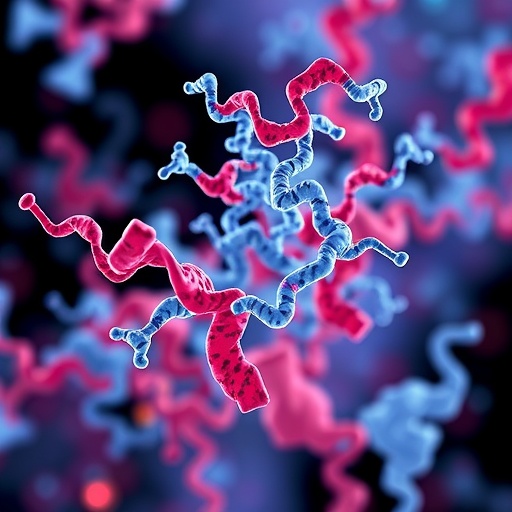Among the most studied protein machines in history, mTORC1 has long been known to sense whether a cell has enough energy to build the proteins it needs to multiply as part of growth. Because faulty versions of mTORC1 contribute to the abnormal growth seen in cancer, drugs targeting the complex have been the subject of 1,300 clinical trials since 1970.
Now a new study finds that mTORC1 has a second function of profound importance: controlling how "crowded" human cells become.
Led by researchers at NYU School of Medicine and published online in the journal Cell on June 21, the finding explains for the first time the workings of a physical quality that cells use to regulate their actions, and more closely links malfunctions in mTORC1-related genes to several diseases of aging.
"Our results begin to clarify how mTORC1-driven changes in crowding could cause the insides of human cells to solidify as a person ages, packing more proteins into the same space and interfering with functions that require them to move around," says senior study author Liam Holt, PhD, assistant professor in the Institute for Systems Genetics at NYU Langone Health. "This work may also help explain the origin of the solid protein clumps that appear in the cells of patients with cardiovascular diseases, diabetes and Alzheimer's."
Freedom to Move
Based on past studies, biologists have long concluded that cells require for survival a limit on the number of proteins in their fluid-filled inner spaces, the cytoplasm where many cellular functions occur.
Specifically, the current study found that the mTORC1 complex controls crowding by determining the number of ribosomes, multi-protein machines that build other proteins there.
By engineering cells to make their own glowing tracers to measure crowding, the researchers showed that, by adjusting levels of mTORC1 action, they could cause a two-fold swing in the ability of multi-protein cellular machines to move around (diffuse) in the cytoplasm of human kidney cells.
Experiments further confirmed ribosomes as the main "crowding agent" regulated by mTORC1, influencing the physical environment of large molecules – like those particularly important to cell growth and death – but leaving alone reactions depending on single proteins.
Many proteins are barely dissolved in the cell, with as much chance of glomming onto each other as to interact with the liquid surrounding them. Crowding increases the chances that these like-structured molecules will together undergo a shift from one state of matter to another (e.g. liquid to a solid), say the authors. In one such "phase transition," similar proteins spread out in the cytoplasmic fluid come together to form dense liquid droplets, the way oil forms its own globs in vinegar.
"The biological consequences of phase changes are an area of intense inquiry right now, with emerging theories suggesting that genetic material, for instance, forms droplets that help to turn genes on and off," says Holt, also faculty in the Department of Biochemistry and Molecular Pharmacology at NYU Langone Health.
By separating protein complexes into phase-separated droplets, or into even denser gels, the cell forms semi-compartments that do not mix as freely with their surroundings, spaces in which more distinct, faster biological reactions can proceed.
The current study suggests that malfunctioning mTORC1 may increase crowding, and therefore cause droplets and gels to become the solids found in cells with diseases of aging – like the tau fibers that build up in the brain tissue of Alzheimer's patients.
Furthermore, the decades of limited success by mTORC1-based cancer drugs could proceed in part from the crowding effect, says Holt. For example, mTORC1 activation may be important to initiate cancer in some cases, but could hinder aggressive growth later as cancer cells become crowded with ribosomes. Thus, the current line of work may help to set new guidelines about when to use mTORC1 inhibitors based on the stage of a patient's cancer.
Moving forward, the team also is studying how crowding affects phase change in different cell types, with the long-term goal of designing anti-crowding therapies for neurodegeneration and cancer.
###
Along with Holt, authors of the current study were first authors Morgan Delarue and Greg Brittingham of the Institute for Systems Genetics at NYU Langone Health, along with Sudershan Pinglay, and Dajun Sang. Also, a first author of the study was Stefan Pfeffer of Department of Molecular Structural Biology at the Max Planck Institute of Biochemistry in Martinsried, Germany, along with authors Miroslava Schaffer, Jurgen Plitzko, and Ben Engel. Also making important contributions were study authors Ivan Surovtsev and Christine Jacobs-Wagner from the Department of Molecular, Cellular, and Developmental Biology at Yale University; Kristopher Kennedy and Juan Gutierrez in the Department of Molecular and Cell Biology at Berkeley; and Jean Chung and Jay Groves in the Department of Chemistry at Berkeley. Surovtsev, Jacobs-Wagner, and Groves are also investigators of the Howard Hughes Medical Institute (HHMI).
The study was funded by the National Science Foundation's Graduate Research Fellows Program, the William Bowes Fellows program, the Vilcek Foundation, and an HHMI Collaborative Innovation Award.
Media Contact
Greg Williams
[email protected]
212-404-3500
@nyulangone
http://nyulangone.org/




